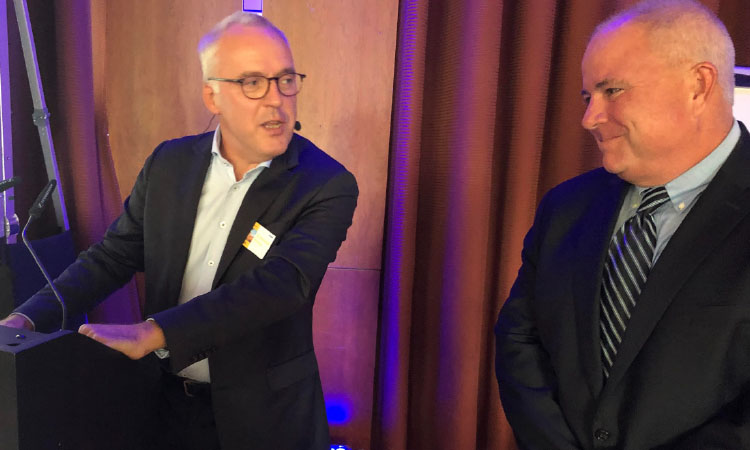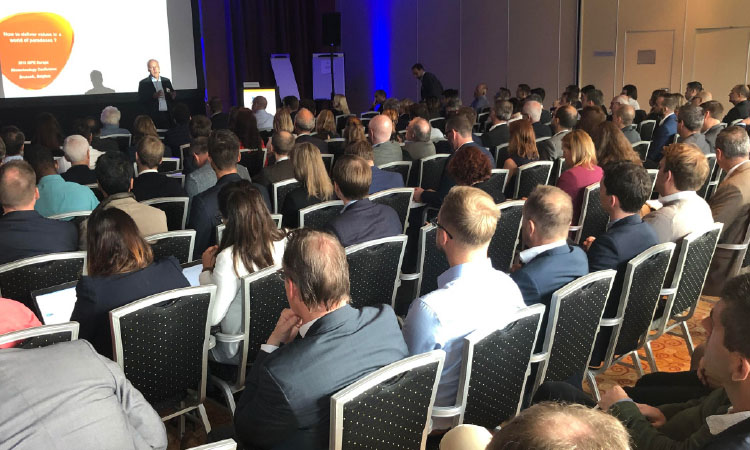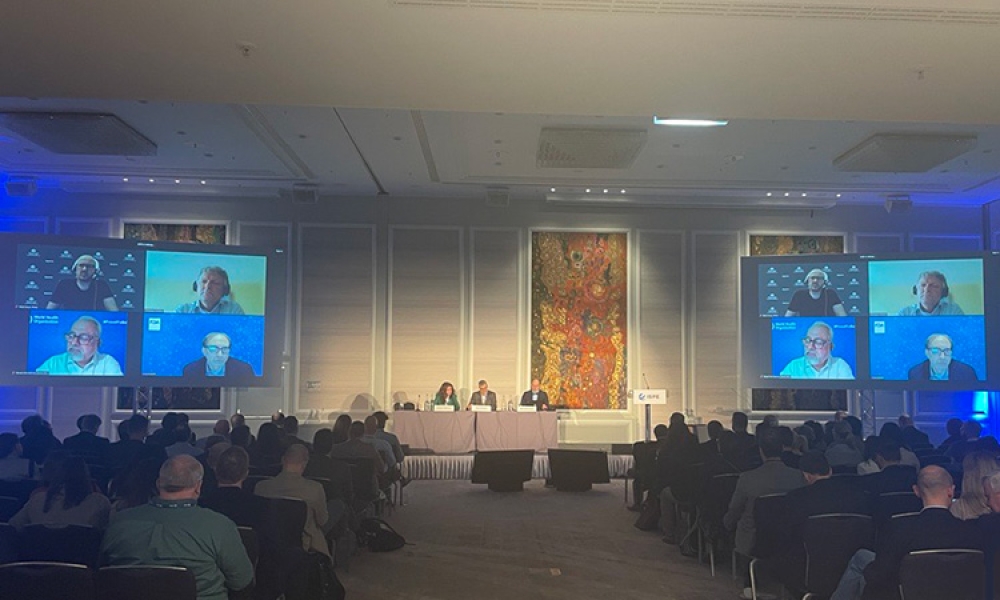2019 ISPE Europe Biotechnology Conference: Industry Transformations

As biopharmaceuticals have become a major part of the pharmaceutical industry, we have witnessed significant transformations in product development, strategy, technology, and operations. This ongoing transformational process was the main theme of the fourth annual ISPE Europe Biotechnology Conference, 25–26 September 2019, in Brussels, where featured tracks included Gene and Cell Therapy, Regulatory & Quality, Digitalization and ISPE Pharma 4.0™, and Operational Innovation.
Although the 280 attendees were excited about innovations such as gene and cell therapy, which are making promising advances in regenerative medicine and disease remission, conference participants also acknowledged that there are considerable operational and technological challenges to overcome. For example, reproducing large molecules reliably at an industrial scale requires manufacturing capabilities of a previously unknown level of sophistication. The starting materials used to produce recombinant therapeutics are genetically modified living cells that must be frozen for storage, thawed without damage, and made to grow in a reaction vessel. The molecules must then be separated from the cells that made them and the media in which they were produced, all without destroying their complex, fragile structures.
Also, biopharmaceutical manufacturing involves distinctive GMP- and quality-related challenges. For example, when working with a nonsterile start-ing material in a sterile and aseptic manufacturing process, it is necessary to prove that the microorganisms in the biopharmaceutical product are from the starting material only, and not from processing.
Presenters at the conference addressed these topics, often offering insightful industry case studies, and attendees also had opportunities to take part in plant tours. Some of the excellent presentations are covered here.

Emmanuel Amory, GSK
Emmanuel Amory, Vice President of International Operations, GSK Vaccines, and Conference Chair, opened the conference by talking about the future of the biopharmaceutical industry. He addressed operations management, industrial excellence, project management, business development, and international leadership as key success factors in the biopharma world of tomorrow.
He identified the competing driving forces in the industry as demand agility versus constrained environment, cost of compliance versus price erosion, liquid generation versus rigid organization, and long-term investment versus short-term return. According to Amory, enablers of success in this environment are collaborative culture, advanced capabilities, and agility by design.
| Traditional Process Control | Advanced Process Control |
|---|---|
| Fixed controlled input parameters | Flexible input parameters |
| Offline analysis | Process analytical technology (PAT) used for online analytics |
| In-process tests primarily for go/no-go decisions |
Real-time automatic control with appropriate feed forward/backward controls |
| Drug product quality controlled by process intermediates and end-product testing |
Drug product quality controlled by real-time release testing (RTRT) with more limited end-product testing |
When defining optimization parameters, industry stakeholders should add predictability alongside the usual ones, such as replenishment frequency, speed, and release frequency.
Paul McKenzie, CSL Behring
Paul McKenzie, Chief Operating Officer, CSL Behring, showed innovation by the numbers in his presentation. When the 2019 ISPE Europe Biotechnology Conference took place, there were approximately 800 gene therapies in clinical trials, about 130 cell therapies in trials, and almost 800 regenerative medicines being tested. In 2018, global investment volume was about USD 172 billion, nearly half of which was focused on oncology and immunooncology.
McKenzie also outlined three pivotal ways that leadership can drive innovation: find the intersections where innovation can happen, reward and recognize innovation across the organization, and foster a culture of diversity and inclusion. He explained that corresponding obstacles to innovation include failing to look ahead and take advantage of change, lacking focus on transformational innovation, and not engaging stakeholders early and often.
Where can engineers create intersections for innovation? McKenzie identified modeling/analytics, operations intensification, design to value (DTV), and scale-down and prototyping as key areas. Engineering sciences provide opportunities for innovation in computational fluid dynamics modeling, process modeling, dynamic facility modeling, statistical modeling, and advanced analytics. For example, these methods can support transitions from traditional process control to advanced process control (Table 1).
McKenzie further explained that DTV strengthens the connections among the development, supply chain, and commercial sectors, to the benefit of patients. In fact, DTV means investing in value throughout the product life cycle:
- Design attribute decision-making guided by marketplace input
- Integration of customer input into product and supply chain design
- Platform-based development, robust process capability, and knowledge management
- Deep understanding of critical quality attributes
- Real-time control and release, clinically based specifications
- Right first-time approval
- Speed to launch and stabilization
- Reliable supply and proactive customer-driven product roadmaps

Brussels in September 2019.
Manufacturers of the future will have multiple factors to consider: market size and cost as a function of throughput; initial capital outlay as a function of the likelihood of clinical success; network size and use as a function of the uniqueness of the product and process; and price as a function of the company's market segment.
McKenzie proposed a systematic approach to development of the optimal design space that includes the creation of subspaces for stability, bioavailability, and processability. In general, future development in the industry will focus on prototyping, finding the means to receive rapid feedback on prototypes and workflows, and continuous improvements.
Uwe Gottschalk, Lonza
Uwe Gottschalk, PhD, Chief Scientific Officer, Lonza Pharma Biotech & Nutrition, presented “Applying Old Know-how to New Challenges: The Manufacturing of Emerging Therapeutic Modalities.” He addressed five technologies that will disrupt healthcare in the near future:
- Artificial intelligence
- Immunotherapies (checkpoint inhibitors)
- Liquid biopsy, which has the potential to monitor tumors noninvasively
- Three-dimensional (3D) printing
- Clustered regularly interspaced short palindromic repeats (CRISPR)
The biggest disruptor is personalization.
The therapeutic modalities considered by Gottschalk are antibiotics, vaccines, proteins, cell therapy, and gene therapy. The enabling platforms are single-use technologies, mammalian cell cultures, centralized large-scale facilities, and high-throughput screening. Onto these, the following disruptors will have an impact: microbiotics/phages, RNA/nucleic acids, mRNA/gene therapy, exosomes, gene editing, integrated process chains, synthetic biology, GMP in a box/point-of-care manufacturing, and predictive in silico tools.
However, he noted, the biggest disruptor is personalization. The cell and gene therapeutic market is a dynamically growing segment, with more than 500 companies developing over 1,300 products. The compound annual growth rate was 27% between 2014 and 2017, with growth driven by key macro factors such as:
- The population over the age of 60 will double by 2050.
- The middle class will become a larger proportion of the global population.
- Sequencing cost is dropping rapidly, making personalized treatments increasingly practical.
- The chance of successful drug development with personalized medicine is increasing, as exemplified by the leap in orphan drug indication approvals with relatively small/less-expensive clinical tests.
Personalized medicines will still be costly for patients, but in some cases these therapies will still be less costly than the total cost of care. Gottschalk said the industrialization of cell and gene therapy manufacturing involves two types of scale-up strategies: centralized scale-up or decentralized scale-out. As an example, for centralized scale-up, he showed the development of human pluripotent stem cells (hPSCs). Contributing and enabling factors to achieve quality, quantity, consistency, and efficiency are:
- High fold expansion to meet cell quantity demand for clinical indications
- A closed process to comply with cGMP requirements and reduce contamination risk
- Automated, scalable, controlled, and monitored stirred-tank bioreactors
- Enhanced in-process control
- Reduced labor requirements and cost
- High-quality hPSCs
Another example discussed by Gottschalk was commercial exosome manufacturing strategy. Exosomes are surrogates of their parental cell and contain genetic material representing the parental cell (RNA, DNA, and protein). They are communicators between cells, intervening in horizontal gene/protein transfer with preferential delivery sites and acting as valuable, well-conserved sources of biomarkers representing the parental (live) cells. When exosomes are used in regenerative medicine treatment, they are commonly made by growing stem cells in culture and then taking the media in which they grow while getting rid of the stem cells by ultra-centrifugation. These products are used to treat orthopedic injuries or combat the effects of aging. The idea is that they will promote tissue repair.
Finally, for the decentralized scale-out strategy, Gottschalk reviewed the complexity of manufacturing of chimeric antigen receptor (CAR) therapies. CARs, which are receptor proteins that have been engineered to give T cells a new ability to target a specific protein, are used for cancer therapy. Manufacturers of these therapies must focus on robustness of process to avoid product failure, efficiency to achieve commercially viable therapies, scale-out to meet commercial demand, proximity to patients to resolve logistical challenges, and key components to reduce complexity in the supply chain.
Sonja Willems, Janssen Benelux
In a presentation titled “The Future of Health Care and the Role of Pharma,” Sonja Willems, Managing Director, Janssen Benelux, addressed three trends: disease elimination, meeting serious unmet needs, and technology.
She said disease elimination will involve three steps: prevention, where disease-specific approaches to warding off disease onset/initiation are the goal; interception, where the target is to stop disease before clinical manifestation; and disease management, where the target is to potentially eliminate disease after it manifests and possibly reverse damage to restore full health. According to Willems, there is a clear trend toward prevention strategies.
The next trend is addressing serious unmet needs. Goals include:
- Achieving a world without tuberculosis
- Ending HIV transmission and reducing the burden of living with HIV
- Ensuring access to quality mental healthcare and promoting well-being for those living with mental illness
- Controlling soil-transmitted helminths as a public health problem
The third trend, technology, is enabling individuals to participate in their own healthcare and disrupting the status quo in research. For example, apps are changing clinical trials by connecting patients with trials they may be eligible to join. These apps have the potential to help patients find trials, get trial information and educational materials, and even offer input about trial design. During trials, apps can be used to conduct experience surveys, pro-mote in-trial engagement, and provide data access for patients. And after a trial, the same apps can be used to distribute plain language summaries, conduct additional experience surveys, and establish long-term connections (an alumni community).
Jakob Harttung, Sanofi
Jakob Harttung, Head of Digital for Sanofi, presented the Sanofi Digital Factory 4.0. In this model, there are five pillars of digital transformation and target outcomes:
- Integrated industrialization will shorten the time to launch and improve robustness of processes and yield.
- Connected plants and equipment will improve capacity utilization and plant cycle time.
- Smart quality will improve operational outcomes and the batch release process.
- Connected teams and operations will enhance training efficiency and support paperless work.
- A real-time, data-driven supply chain will enhance service levels and optimize inventory levels.
From a management point of view, the digital factory is achieved in three phases. It is initially introduced via so-called lighthouse projects and sites that pilot the new approach, followed by early adopters in phase 2. Phase 3 is the scale-out across all sites.
Major plant investments are driven by the digital-by-design concept. In practical terms, this means zero paper, zero destructions, zero runs that can not be sold due to GMP failures, zero inspection issues, zero deviations, zero delayed releases, and zero supply chain delivery failures.
Harttung said one of the key strategies is to overcome a silo mentality that separates manufacturing and R&D by accelerating feedback cycles and learning from other industries. Sometimes, scale-out avoids the risks associated with scale-up and might result in better processes.








